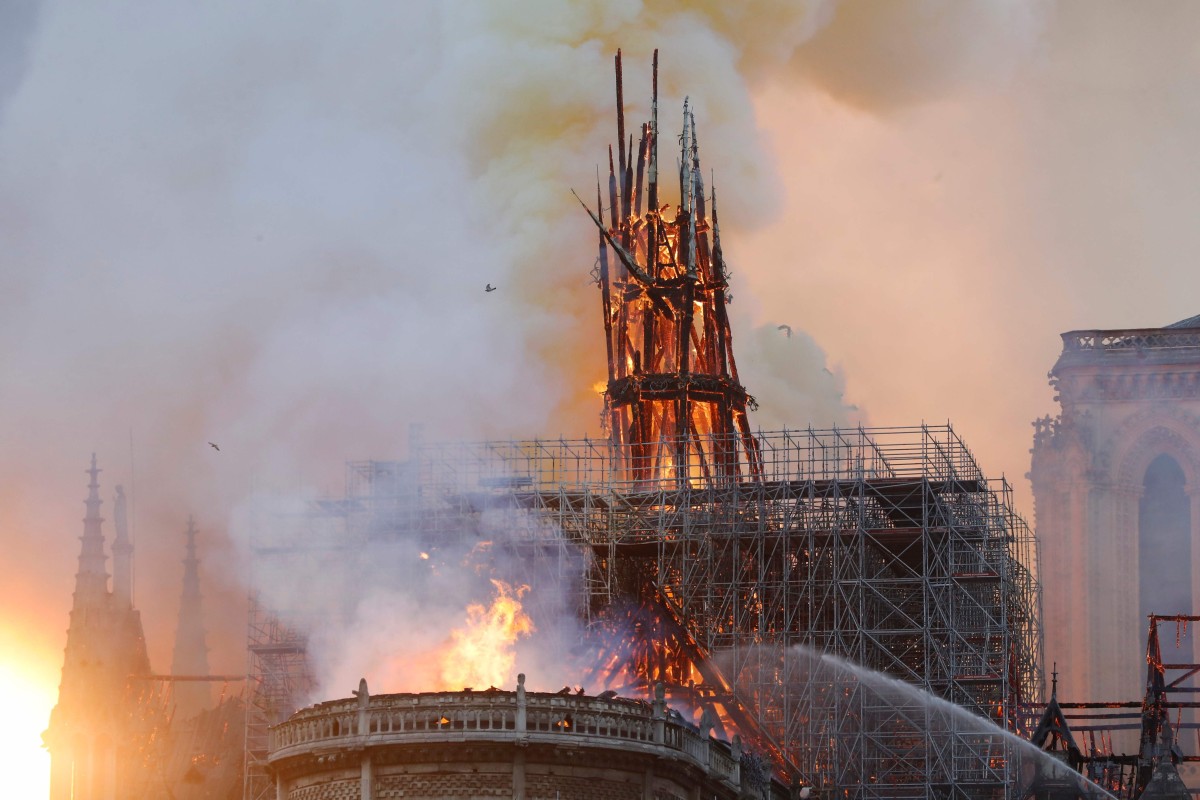Reflections by Wee Kek Koon
How China’s Shaolin Temple survived multiple attempts to destroy it – by the Chinese themselves
Much like France’s Notre Dame Cathedral, the venerated complex has been razed and rebuilt numerous times
Wee Kek Koon
Published: 2:00am, 9 May, 2019

Flames rise from Notre Dame Cathedral in central Paris, on April 15. Photo: AFP
When the Notre Dame Cathedral was burning in Paris last month, some Chinese wasted no time in venting their Schadenfreude online.
According to their logic, the fiery destruction of a cultural symbol beloved by the French was vindication for the burning and looting of Beijing’s Summer Palace by French and British troops in 1860.
In fairness, these jingoistic rants were roundly criticised by many, including China’s heritage and other government bodies, as mean-spirited, misguided and childish.
Named for its location in the forest of Mount Shaoshi, in Henan province, Shaolin Temple is among the most venerated religious edifices in China, and like Notre Dame and many cultural monuments around the world, it has been destroyed, desecrated, razed by fires and rebuilt multiple times.
Most of the structures in the temple complex are less than 100 years old, but the original Shaolin was built more than 1,500 years ago, in 495, by the Northern Wei dynasty’s Emperor Xiaowen for the Indian Buddhist missionary Buddhabhadra, who had arrived in China 30 years earlier.

China’s famed Shaolin Temple, in Henan Province. Photo: Alamy
In 527, another Indian missionary, Bodhidharma, became the abbot of Shaolin. Building on the teachings of Buddhabhadra and others, Bodhidharma founded the school of Buddhism known as Chan (better known worldwide by its Japanese pronunciation, Zen).
Shaolin was revered as a place of great Buddhist learning, with erudite monastics and an extensive library. It enjoyed imperial patronage, even hosting the Tang period’s Emperor Gaozong and Empress Wu Zetian in the 7th century and Emperor Qianlong of the Qing dynasty in 1750.
Notre Dame Cathedral fire was ‘likely caused by short circuit’
The temple also developed martial arts techniques for self-defence and fitness, which have been so exaggerated and lionised in popular culture that they now overshadow the temple’s religious and intellectual pursuits.
Shaolin was not immune to disasters. In the 570s, the temple suffered its first calamity when Emperor Wu of the Northern Zhou dynasty launched his anti-Buddhist campaign, which practically destroyed all Buddhist temples in northern China, including Shaolin.
Whatever that was left or restored was again destroyed in 618, when armed bandits looted the temple and burned most of it to the ground.
Two centuries later, the Tang dynasty’s Emperor Wu launched another persecution of the religion, which resulted in the destruction of almost all Buddhist temples in the whole of China. Shaolin, as the pre-eminent beacon of Buddhism in the empire, did not escape the emperor’s wrath.
After that, Shaolin did not suffer any tragedy of catastrophic consequence until the early 20th century. After a fierce battle between two rival warlord cliques in the spring of 1928, Shi Yousan, a commander of the winning side, set out to destroy Shaolin just because his counterpart on the losing side had used the temple as a temporary command centre.
Fanned by a delirious fury – the same post-battle madness that afflicted imperial-era military commanders who reduced their defeated enemies’ cities or palaces to ashes – Shi doused the buildings in kerosene before bombarding them with artillery fire, ensuring that the destruction would be absolute.
When the madness of the Cultural Revolution swept across China 40 years later, Shaolin was, of course, not spared. Many of its images and buildings were wrecked, and its monastics were forced to resume their secular lives.
But things have gone well for the temple in the last three decades, culminating in its Unesco World Heritage listing in 2010. The Shaolin Temple still stands, its relative newness a testament of its tenacity in surviving the multiple attempts to destroy it – not by foreigners, but by the Chinese themselves.



 Reply With Quote
Reply With Quote





